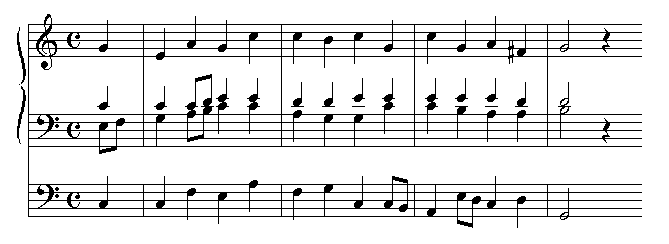
Sound Files | Home |
One of my great ambitions for this Encylopedia is to include sound files for many of the stops. Before I start making field recordings and soliciting contributions from others, a number of questions need to be addressed, and some standards need to be established. This page proposes some standards, and raises some questions.
Each stop will have three different sound clips: individual note samples, a standard musical selection, and an appropriate musical selection.

This clip will consist of exactly the same piece of music for every stop example, so that the sounds of different stops can easily be compared in an apples-to-apples manner.
For this purpose, I have selected the first half of the hymn tune "St. Anne". It should be played as follows:

For solo stops, play the melody only on the solo stop, with a soft
and appropriate accompaniment registration for the other three parts:

The purpose of this clip is to demonstrate the stop in a manner consistent with its common usage. The clip should consist of a short (about 10 second) selection of music. Other stops may be drawn if necessary, but they should be kept to a minimum so that the stop in question can clearly be heard. Well-known musical selections are encouraged. This clip should be recorded in stereo.
The primary purpose of these sound samples is to let the listener hear the differences between different stops, and different examples of the same stop. However, the sound of a stop cannot be properly evaluated except within the context of the instrument to which it belongs. Therefore, I would like (ideally) to have samples of all the important stops from each instrument that is recorded. All of these samples will be available from a page dedicated to that instrument, as well as from the encyclopedia entry pages. Ideally, there would also be samples of ensembles as well as individual stops.
The goal is to obtain high-quality recordings so that subtle differences between different examples of the same stop name can be heard.
Use the most expensive microphone you can afford to buy, rent or borrow. It will most likely be a condenser mike.
It should be monodirectional (not bidirectional or omnidirectional), so that it picks up only what it's pointed at.
It should have a very wide and flat frequency response; the bottom of an 8' stop is about 64hz, a 16' stop 32hz, and a 32' stop 16hz. The high end should be around 20khz.
Place the microphone about 15' from the pipes, aimed at the pipes. The idea is to be close enough to eliminate most room noise and reverberation, but far enough away for the sound to have "developed".
Recordings should be made directly to an uncompressed digital format such as DAT. Sample rate should be 44.1khz (same as for commercial audio CD's). Sample size should be at least 16 bits.
This is possibly the biggest remaining issue to be resolved. The room into which an organ speaks is an integral part of the instrument, acoustically speaking. How much of the room do we want to capture? The sound of the pipe at a distance of a few inches is significantly different from its sound a few hundred feet away. I think that avoiding extremes (i.e. inside the chamber or at the opposite end of the room from the organ) is a good idea, and suspect that the ideal mike placement will probably be a handful of feet in front of the facade. Ultimately, I plan to base my decision largely on empirical studies, which will be available on this web site as soon as I get a chance to make some field recordings. Suggestions and opinions, as always, are most welcome.
|
Copyright © 1999 Edward L. Stauff, all rights reserved. SoundFiles.html - Last updated 22 March 2002. |
Home Full Index |